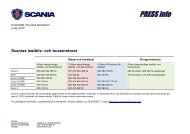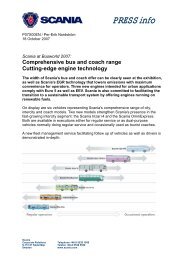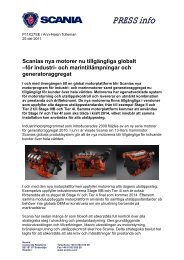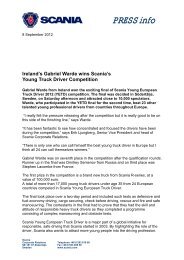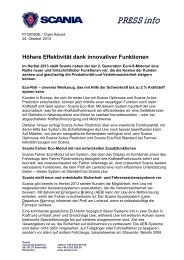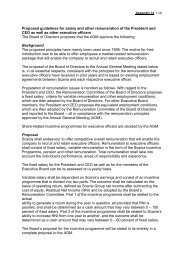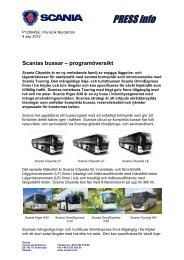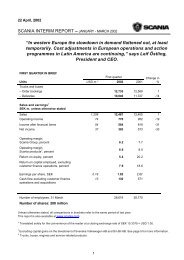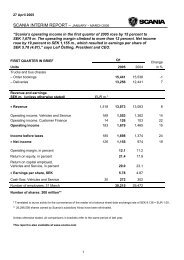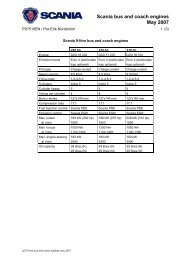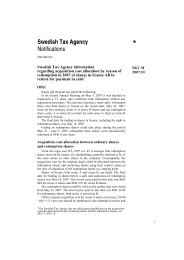Scania annual report 2004
Scania annual report 2004
Scania annual report 2004
Create successful ePaper yourself
Turn your PDF publications into a flip-book with our unique Google optimized e-Paper software.
NOTE 29 Financial instruments and financial risk management<br />
Financial assets in the <strong>Scania</strong> Group consist primarily of financial leases<br />
and hire purchase receivables that have arisen in the Customer Finance<br />
segment as a consequence of financing of customers’ vehicle purchases.<br />
Other financial assets of significance are trade receivables from independent<br />
dealerships and end customers in the Vehicles and Service<br />
segment plus liquid assets. <strong>Scania</strong>’s financial liabilities consist largely<br />
of loans, mainly taken out in order to fund the Customer Finance<br />
segment’s lending and leasing to customers and, to a lesser extent,<br />
to fund capital employed in Vehicles and Service.<br />
Financial assets and liabilities give rise to various kinds of risks, which<br />
are primarily managed by means of various derivative instruments.<br />
<strong>Scania</strong> uses derivative instruments, mainly for the purpose of:<br />
• transforming corporate-level borrowings in a limited number of<br />
currencies to those currencies in which the respectively funded<br />
assets are denominated,<br />
• transforming the interest rate refixing period for funding to the interest<br />
rate refixing period in the Customer Finance loan and lease portfolio,<br />
as well as the desired interest rate refixing period for funding of other<br />
assets,<br />
• converting expected future commercial payments in foreign currencies<br />
to SEK and<br />
• to a lesser extent, converting projected surplus liquidity in foreign<br />
currencies to SEK.<br />
Financial risk management in the <strong>Scania</strong> Group<br />
In addition to business risks, <strong>Scania</strong> is exposed to various financial risks<br />
in its operations. The financial risks that are of the greatest importance<br />
are currency, interest rate, refinancing and credit risks, which are all<br />
regulated by a financial policy adopted by <strong>Scania</strong>’s Board of Directors.<br />
Credit risk related to customer commitments is managed, within established<br />
limits, on a decentralised basis by means of local credit assessments.<br />
Decisions on major credit commitments are made in corporate<br />
Hedging of currency flows 31 December <strong>2004</strong><br />
credit committees. Other risks are managed primarily at corporate level<br />
by <strong>Scania</strong>’s treasury unit. For the purpose of promoting long-term<br />
profitability, <strong>Scania</strong>’s financial policy states that financial risks shall be<br />
minimised and access to liquidity shall be safeguarded. On a daily<br />
basis, the corporate treasury unit measures the risks of outstanding<br />
positions, which are managed within established limits in compliance<br />
with the financial policy.<br />
Currency risk<br />
Currency risk is the risk that changes in currency exchange rates will<br />
adversely affect cash flow. Changes in exchange rates also affect<br />
<strong>Scania</strong>’s income statement and balance sheet as follows:<br />
• Earnings are affected when income and expenses in foreign currencies<br />
are translated to Swedish kronor.<br />
• The balance sheet is affected when assets and liabilities in foreign<br />
currencies are translated to Swedish kronor.<br />
During <strong>2004</strong>, 94 percent of <strong>Scania</strong>’s sales occurred in countries outside<br />
Sweden. Since a large proportion of production occurs in Sweden, at<br />
costs denominated in Swedish kronor, this means that <strong>Scania</strong> has large<br />
net inflows of foreign currencies. During <strong>2004</strong>, total net revenue in foreign<br />
currencies amounted to about SEK 19 billion (18). The largest currencies<br />
in this flow were EUR and GBP. Note 31 shows <strong>Scania</strong>’s net flows in<br />
the most commonly occurring currencies.<br />
Based on the geographic distribution of revenues and expenses<br />
during <strong>2004</strong>, a one percentage point change in the Swedish krona<br />
against other currencies, excluding currency hedging, has an impact on<br />
operating income of about SEK 190 m. on an <strong>annual</strong> basis.<br />
<strong>Scania</strong>’s policy is to hedge its currency flows during a period of time<br />
equivalent to the projected orderbook until the date of payment.<br />
However, the hedging period is allowed to vary between 0 and 12<br />
months. Hedging of currency risks mainly occurs by selling currencies<br />
on forward contracts, but also by means of currency options.<br />
GBP/SEK EUR/SEK KRW/SEK CHF/SEK NOK/SEK ZAR/SEK<br />
Quarter Volume 1 Rate 2 Volume 1 Rate 2 Volume 1 Rate 2 Volume 1 Rate 2 Volume 1 Rate 2 Volume 1 Rate 2<br />
Q 1 3 2005 15 13.04 100 9.22 5 000 0.0063 10 5.99 70 1.10 30 1.16<br />
Q 2 2005 5 13.02 150 9.17 14 6.01 30 1.11<br />
Q 3 2005 140 9.08 15 5.97<br />
Q 4 2005 80 9.05 8 5.96<br />
Total (in millions) 20 13.04 470 9.13 5 000 0.0063 47 5.98 100 1.11 30 1.16<br />
Closing day rate 12.71 9.01 0.0064 5.83 1.09 1.16<br />
31 Dec <strong>2004</strong><br />
Unrealised gain/loss 8.1 59.6 – 0.4 5.4 1.7 0.4<br />
31 Dec <strong>2004</strong><br />
1 Volume is expressed in millions of local currency units.<br />
2 Average forward price and lowest redemption price for currency options.<br />
3 January volumes are not included, since the unrealised gain/loss effect was <strong>report</strong>ed in December.<br />
The effect of currency derivatives on operating income totalled SEK<br />
65 m. (620), of which SEK 31 m. (54) was related to still unexpired<br />
contracts that were offset on the balance sheet date by net assets in<br />
the balance sheet. The value of outstanding contracts not <strong>report</strong>ed in<br />
earnings which will affect 2005 earnings can be seen in the table<br />
“Hedging of currency flows” below.<br />
To ensure efficiency and risk control, borrowings in <strong>Scania</strong>'s subsidiaries<br />
largely occur through the corporate treasury unit in local currencies,<br />
and are then transferred to the subsidiaries in the form of internal<br />
loans. By means of currency swap agreements, the loans are converted<br />
at corporate level to adequate currencies. <strong>Scania</strong>'s borrowings in various<br />
currencies excluding and including currency derivatives can be seen<br />
in the table on page 72 on borrowings and effective interest rates.<br />
At the end of <strong>2004</strong>, <strong>Scania</strong>’s net assets in foreign currencies amounted<br />
to SEK 8,761 m. (10,140). See Note 30. The net foreign assets of<br />
subsidiaries are normally not hedged. To the extent subsidiaries have<br />
significant net monetary assets in local currencies, however, they may<br />
be hedged. At year-end <strong>2004</strong>, no foreign net assets were hedged<br />
(SEK 346 m. in such assets were hedged at the end of 2003).<br />
Interest rate risk<br />
Interest rate risk is the risk that changes in market interest rates will<br />
adversely affect cash flow or the fair value of financial assets and liabilities.<br />
For <strong>Scania</strong>’s assets and liabilities that carry variable interest rates,<br />
a change in market interest rates has a direct effect on cash flow, while<br />
for fixed-interest assets and liabilities, the fair value of the portfolio is<br />
instead affected. At year-end <strong>2004</strong>, <strong>Scania</strong>’s interest-bearing assets<br />
consisted primarily of assets in the Customer Finance segment and to<br />
a certain extent of liquid assets. Interest-bearing liabilities consisted<br />
mainly of loans, to a great extent intended to fund lending in Customer<br />
Finance operations and to a lesser extent to fund working capital in<br />
Vehicles and Service. To manage interest rate risks, the Group mainly<br />
uses interest rate derivatives in the form of interest rate swap agreements.<br />
Borrowing in Vehicles and Service is mainly used for funding of<br />
working capital, which means that a short interest rate refixing period<br />
matches the turnover rate of working capital. <strong>Scania</strong>’s policy concerning<br />
interest rate risks in the Vehicles and Service segment is that the interest<br />
rate refixing period on its loan portfolio should normally be 6 months, but<br />
that deviations are allowed in the range between 0 and 24 months. At<br />
year-end, the loan portfolio in Vehicles and Service amounted to SEK<br />
3,050 m. (4,427) and the average interest rate refixing period was about<br />
3 (3) months.<br />
Given the same loan liabilities and interest rate refixing period as at<br />
year-end <strong>2004</strong>, a change in market interest rates of 100 basis points<br />
(1 percentage point) would change the interest expenses in Vehicles<br />
and Service by about SEK 25 m. on an <strong>annual</strong> basis. Due to the short<br />
interest rate refixing period, the fair value of the loan portfolio would not<br />
be significantly affected.<br />
<strong>Scania</strong>’s policy regarding interest rate risks in the Customer Finance<br />
segment is that lending and borrowing should match in terms of interest<br />
rates and maturity periods. Interest rate refixing in related to the credit<br />
portfolio and borrowing in Customer Finance had the following structure<br />
as of 31 December <strong>2004</strong>:<br />
Continued<br />
71 NOTES • SCANIA ANNUAL REPORT <strong>2004</strong>



